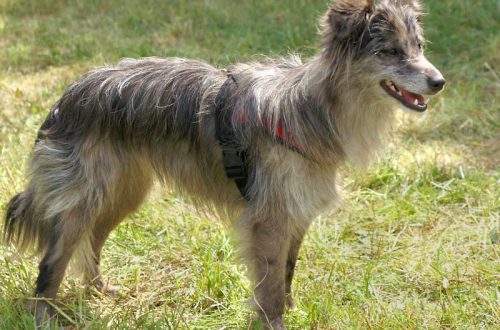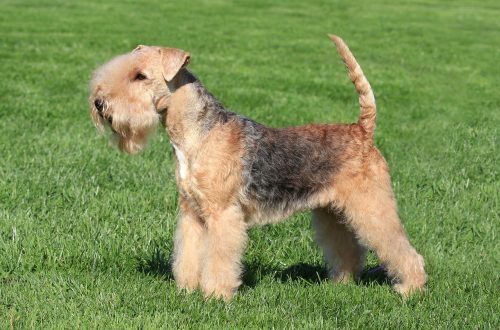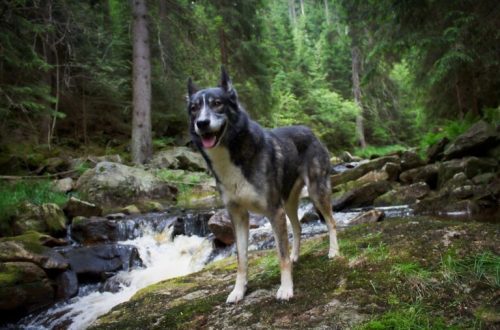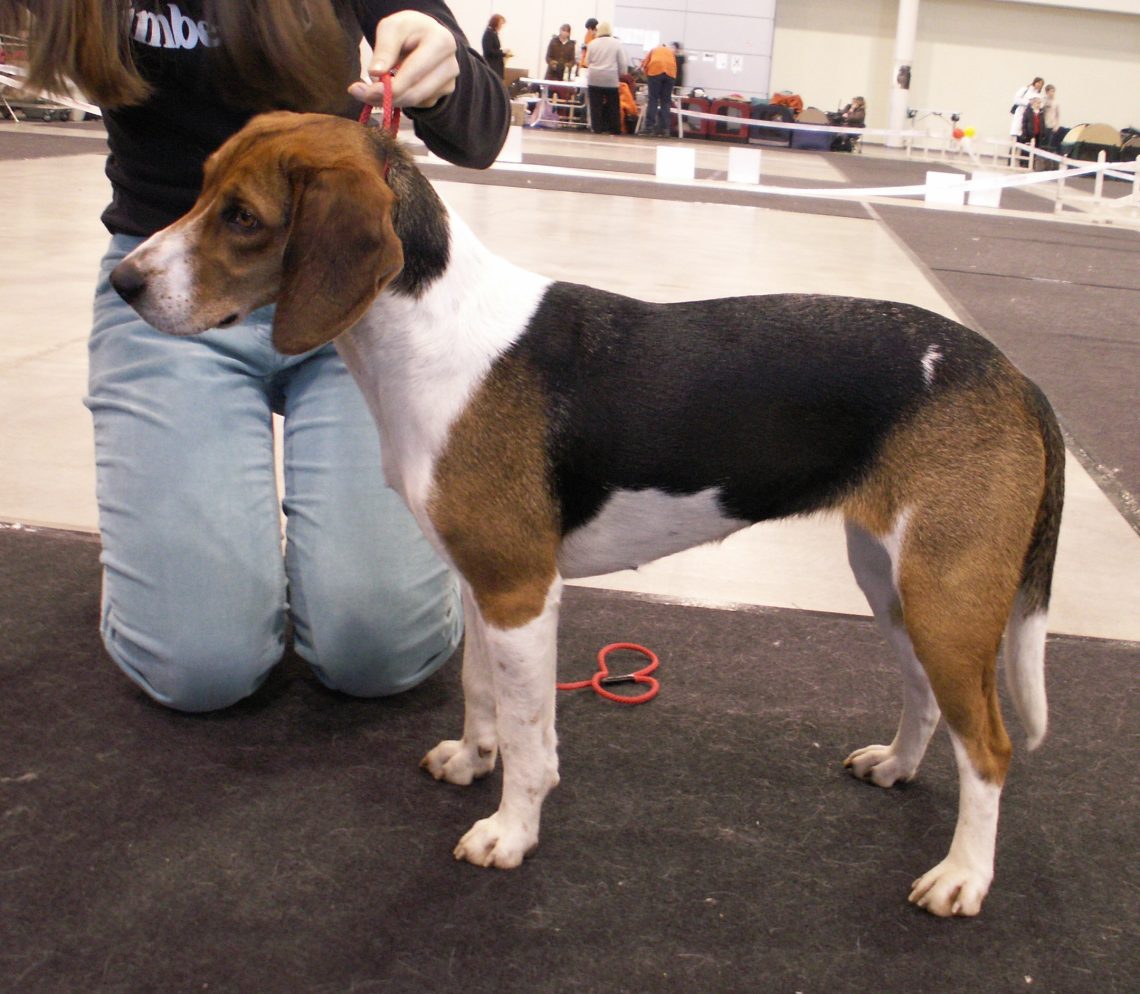
Естонски гонич
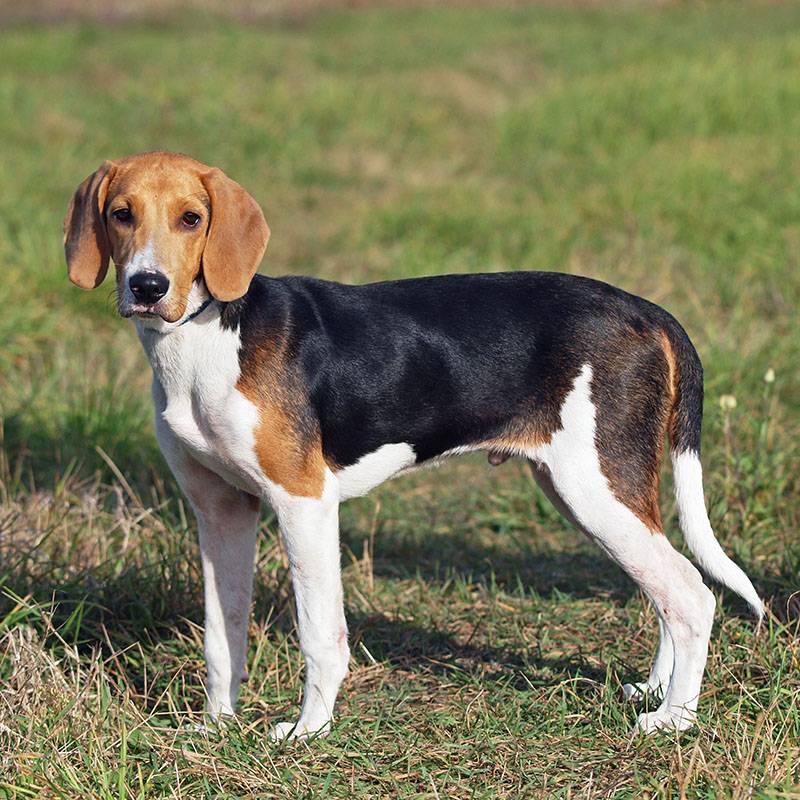
Садржај
- Characteristics of Estonian hound
- Основни моменти
- History of the Estonian Hound breed
- Video: Estonian Hound
- The appearance of the Estonian hound
- Photo of the Estonian Hound
- The nature of the Estonian hound
- Образовање и обука
- Care and maintenance Estonian hound
- Health and disease of Estonian hounds
- Како одабрати штене
Characteristics of Estonian hound
The Estonian Hound is a hunting dog. She is agile, energetic and athletic. Differs in working capacity and endurance.
| Земља порекла | Естонија |
| Величина | средњи |
| Раст | КСНУМКС-КСНУМКС см |
| тежина | КСНУМКС-КСНУМКС КГ |
| старост | до КСНУМКС година |
| ФЦИ расна група | nije priznato |
Основни моменти
- The Estonian Hound is not tall, but very strong and muscular.
- The vocation of representatives of this breed is hunting fox and hare, but they are also able to drive larger game.
- The dog is tireless in pursuing the beast in all weather conditions, merciless towards the victim.
- The hound has a melodic sonorous voice, which allows it to notify the owner from afar about the location of the game.
- The dog treats its owners with love and devotion, always ready to defend the house.
- The Estonian hound is not at all capricious, very executive, obedient. Tolerant to children, does not pose a danger to them.
- With animals living with her in the same house for a long time, coexists peacefully.
- The Estonian Hound is active, agile, playful, but not pushy. At home, her vigor is not destructive.
- The breed needs regular exercise and long walks.
- A dog needs training, otherwise it will grow up spoiled, wayward, naughty.
- The Hound feels comfortable in a city apartment, but still a country house is a more preferable option for her living.
- If necessary, the Estonian hound can be kept in an aviary, but only in warm weather. In winter, a short-haired pet should be in a heated room.
- The content of this dog does not cause trouble to its owners. She is unpretentious, clean, and caring for her short hair is easy.
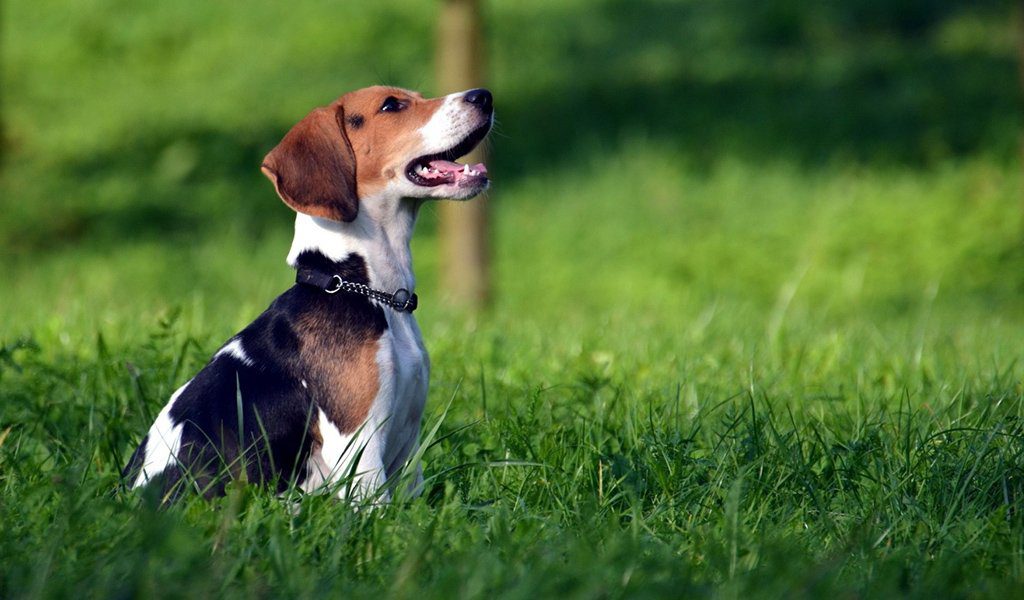
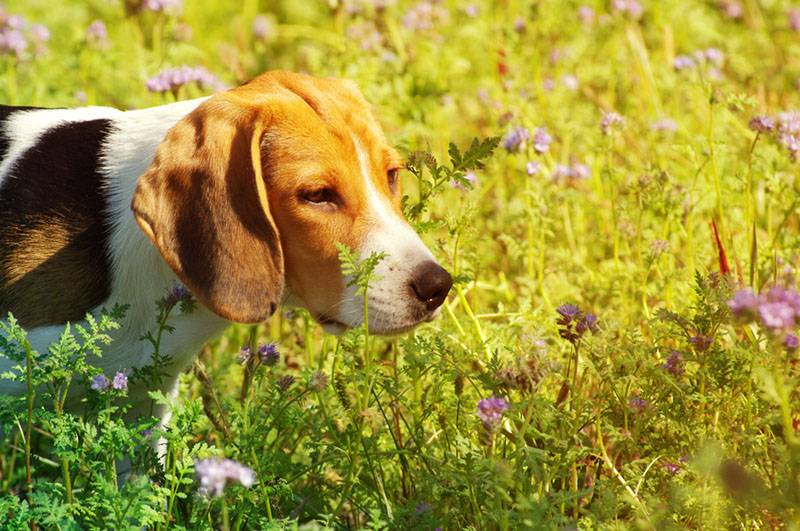
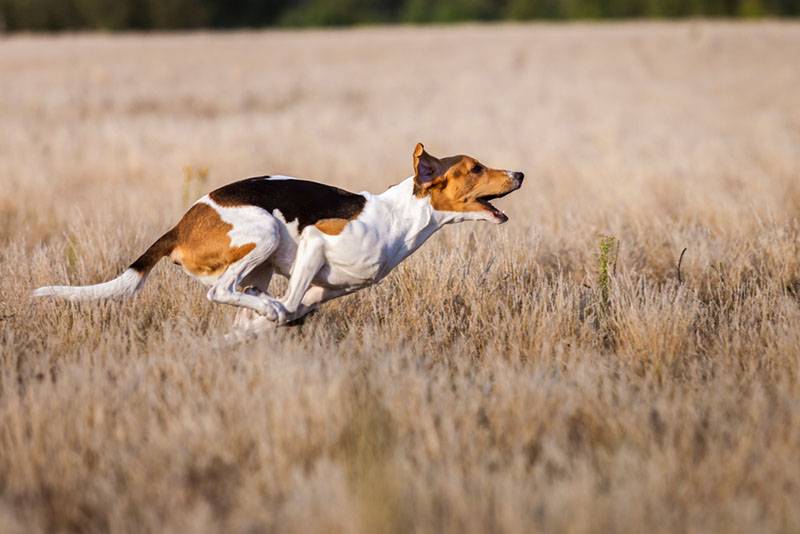
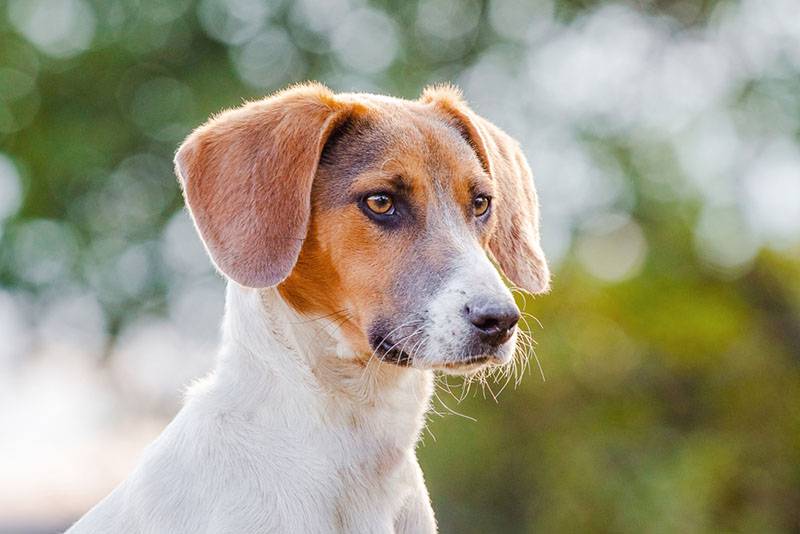
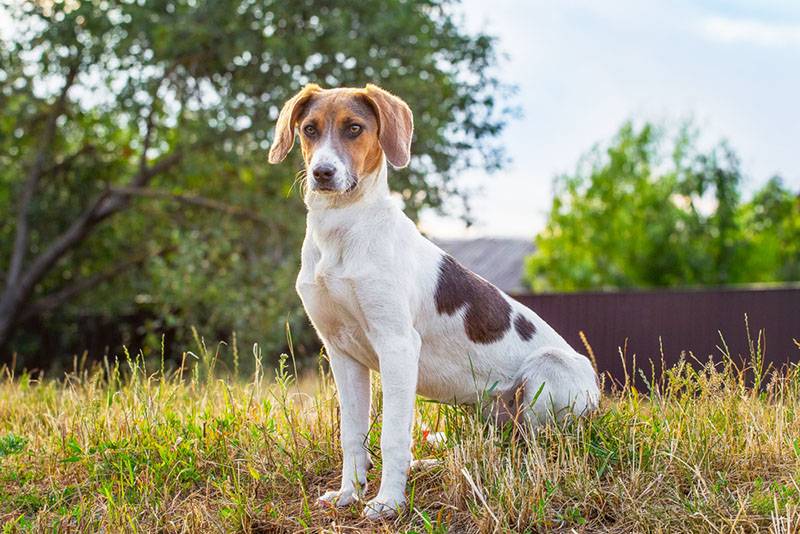
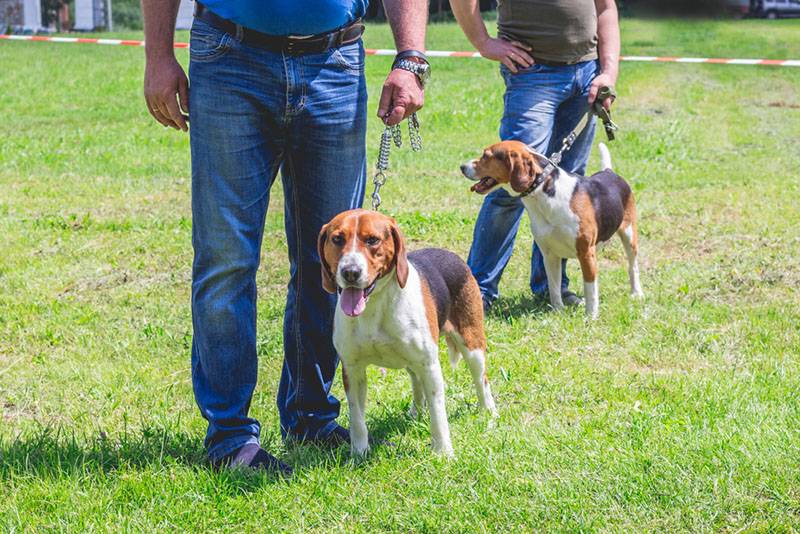
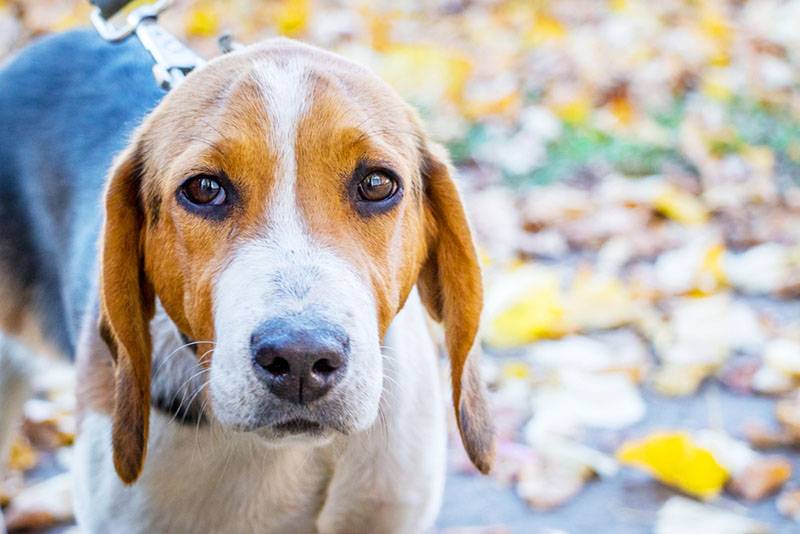
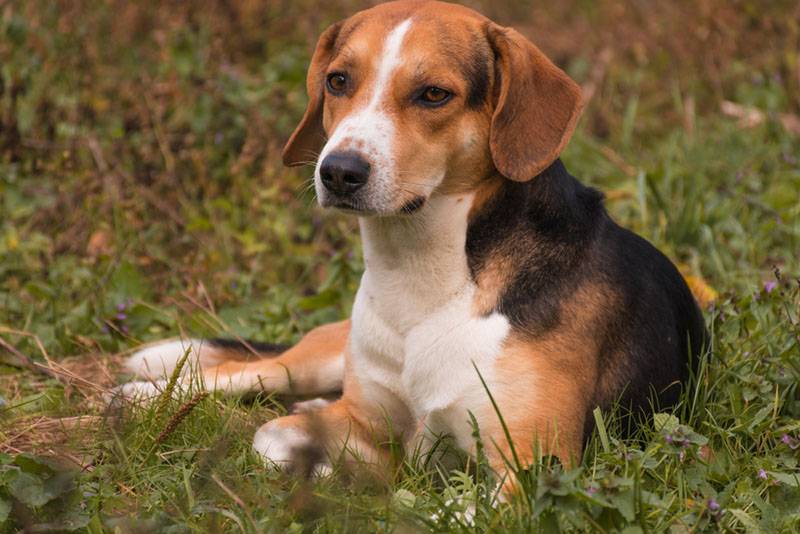
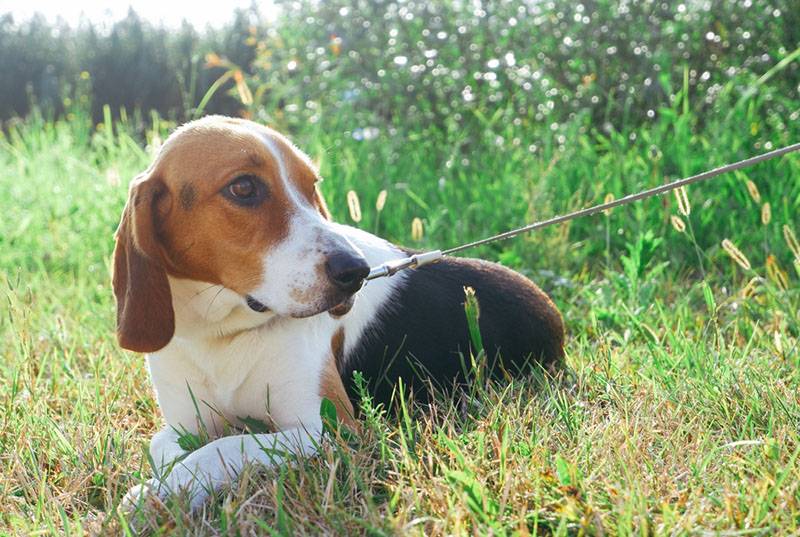
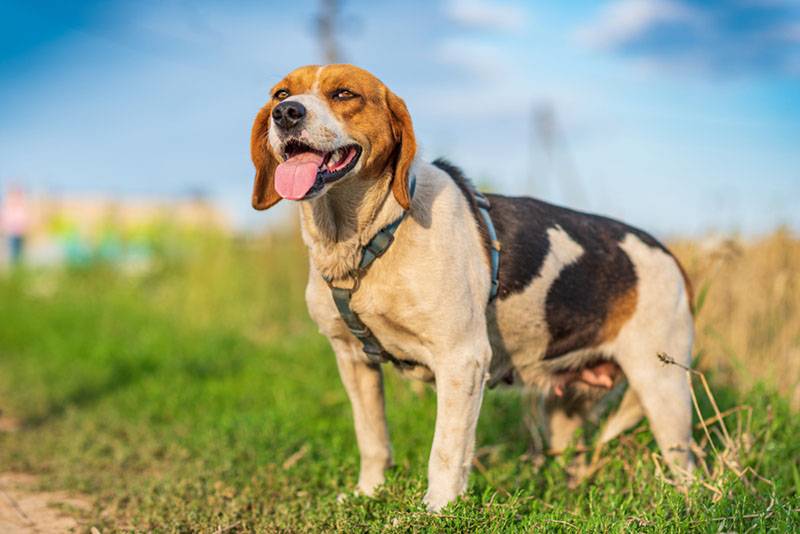
The Estonian hound , zealous, reckless, tireless, is the dream of any hunter! In work, she is in no way inferior to Russian greyhounds and “pegasus”, sometimes surpassing the latter, because it is easier for her to overcome obstacles due to her small stature. But this beautiful, energetic, mischievous, always positive-minded animal is popular not only in a narrow circle of hunting enthusiasts. A dog often becomes just a member of the family, a pet, delighting the owners with its excellent qualities. Affectionate, loyal, friendly, always ready to go on a long journey, the Estonian Hound is an excellent friend and companion for people who are fond of sports and who love an active lifestyle.
| Разлози Loyalty to its owner; Hardworking hunters; Добро се слагати са децом; Wool does not require frequent care. | ПРОТИВ Потребна је дуга шетња; Often they chase after living creatures; Can bark loudly Захтева рану социјализацију. |
History of the Estonian Hound breed
The breeding of hound dogs began to be systematically bred in Estonia in the middle of the 18th century. Initially, Russian and Polish hounds were used for breeding, at the end of the century before last, hunting dogs from England were imported into the Baltic States. By the 1920s, local hunting dogs became known as Russian-Polish or Russian-English hounds.
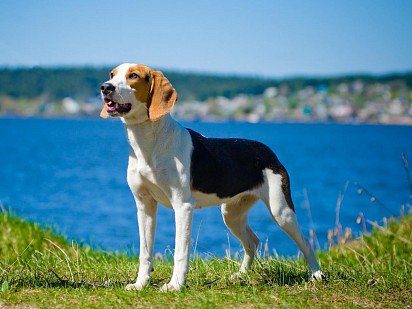
In 1934, new rules for hunting were adopted in Estonia, as in the hunting grounds, the territory of which was very small, the number of animals was catastrophically reduced, and the roe deer population was completely on the verge of extinction. According to the new rules, hunting with dogs was allowed only for small and medium-sized animals, and the height of the hounds was limited to 45 cm at the withers. Since that time, work began on the creation of a short hound, which was supposed to retain all the working qualities inherent in a hunting dog. Work on breeding a new breed continued for more than 20 years, and they were led and coordinated by the Estonian cynologist Sergey Smelkov, who rightfully took the pedestal of the creator of the Estonian hound breed.
Initially, the smallest of the local hounds were selected for selection and crossed with the undersized English hare hound – the beagle. The technique was comprehensively thought out, because not only such a sign of the future breed as short stature was fixed. The English Beagle was also selected for its strong legs, dense and strong paws. These qualities are ideal for Estonian winters with little snow, when hunting trails here often become hard as stone and completely unsuitable for hunting with light-footed dogs. However, such shortcomings of the beagle as a discordant rough and deaf voice, late formation of hunting instincts, insufficient parasity (the speed with which the dog pursues the beast), prompted Smelkov to involve the Swiss hound in the creation of a new breed. Not having a strong enough paw, she, nevertheless, interested breeders in her small stature, excellent viscosity,
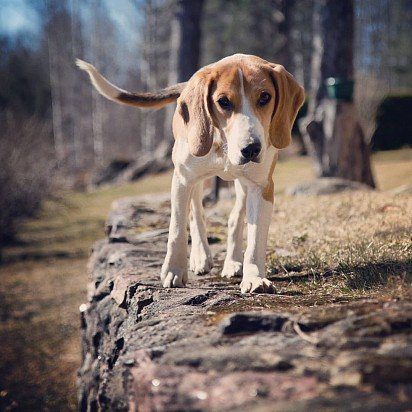
It is worth saying that Finnish hounds, English fox hounds, Russian hounds were also involved in the selection work. By crossing them with standard local hounds, Smelkov intended to breed separately fairly large hunting dogs (52-60 cm). Actually, back in the 40s, the future breed of the Estonian hound was very diverse, and manifestations of this feature of it are sometimes recorded in the exterior of the animal to this day.
In 1947, the Ministry of National Economy of the USSR took the initiative to oblige each of the fifteen republics to be represented by its own breed of dogs. By this time, there were 800-900 hounds in Estonia, belonging to the Estonian-English-Swiss breeding line that came out on top. In 1954, 48 individuals typical of this line, tested in hare and fox hunting, passed a specialized commission and were recognized by the USSR Ministry of Agriculture as a separate breed, called the Estonian Hound. In 1959, the commission of the Kennel Council of the USSR approved the breed standard. By the beginning of the eighties, there were 1750 purebred Estonian hounds in the Soviet Union.
Today, representatives of the original Estonian breed are found mainly in the Baltic countries, in Finland, and Russia. Despite the efforts of local cynologists, the International Cynological Federation (FCI) is still unwilling to recognize the breed. Its standard, approved in 1959, is still valid today, but in 2007 minor changes were made to it regarding the color of the dog.
Video: Estonian Hound
The appearance of the Estonian hound
The Estonian Hound is a muscular dog of small size, lean type of constitution, with solid, strong bones. Her physique is proportional, the length of the body significantly exceeds the height at the withers. Unlike the squat and frankly stocky beagle, with whom the Estonian hound is often confused, the latter shows elegant and graceful features.
Estonian hound Frame
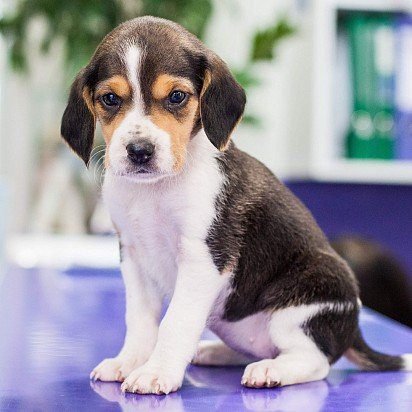

The line of the back is straight, sloping from the withers to the sacrum. Both the back and the croup are broad and muscular. The voluminous elongated chest has the shape of an oval, it is lowered to the elbows and extends to a moderately tucked-up abdominal wall.
Глава
The skull is moderately wide, with curved forms, the line of transition to the muzzle looks quite smooth, without a sharp break. The very same muzzle is elongated, straight, proportional to the skull. Superciliary ridges stand out distinctly, but not superciliously. The nose is broad, fleshy, black in color, its intensity varies with different colors. Lips are dry, not hanging, totally pigmented.
Зуби и вилице
The teeth are white, large, they should be 42. Scissor bite, the upper incisors confidently cover the lower ones. As the dog ages, as the incisors wear off, the bite may change to a straight bite. Strong jaws of the Estonian hound are well developed. Cheekbones lean, without bulges.
очи
The eyes of the Estonian hound are slightly slanted. Their color is dark brown.
уши
The ears are rather thin, hanging close to the cheeks. Covered with short fur. Their base is located on the line of the eyes. If you extend the ears towards the nose, they will reach approximately to the middle of the muzzle. The tips of the ears are noticeably rounded.
врат
The rounded muscular neck of the hound is of medium length. There are no folds on the skin in the neck area.
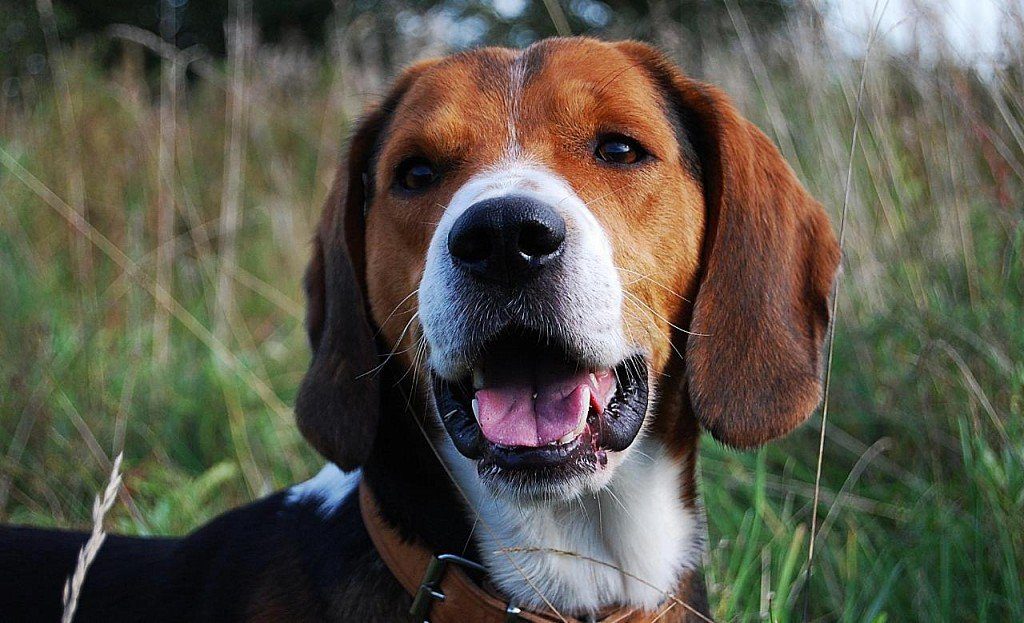

Estonian hound limbs
The forelimbs are lean, with well-developed muscles. Seen from the front, they look straight and parallel. Their length is approximately half the height of the animal at the withers.
The elbows are strong, close to the body, neither protruding in nor out. Large, absolutely straight, proportional to the body forearms are of medium length. The pasterns are solid, strong, set almost vertically.
The hind limbs of the Estonian hound are powerful, bony, and muscular. From behind, they look straight and parallel to each other. Articulation angles are clearly visible. The thighs and lower legs are almost identical in length. Knee joints are strong, with moderate angulations. When the dog is in motion, they should not turn in or out. Strong metatarsus of medium length, located vertically.
The paws are arched, elliptical in shape, the fingers are closely pressed to each other. Pads and claws directed to the ground, large, dense.
Ход
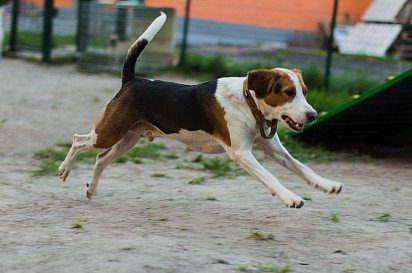

The Estonian Hound moves freely, evenly, plastically, rectilinearly, resiliently. The push of the hind limbs is very powerful, confident.
Estonian hound Tail
Thick at the base, covered with thick hair, the tail gradually tapers to the tip, it has a saber-like shape, reaching the hock. During the movement of the Estonian Hound, the tail must not rise above the line of the back.
Вуна
Short, straight, hard, even coarse, shiny. The undercoat is very poorly developed.
boja
The characteristic color for the breed is black and piebald on a white background with the so-called blush – marks, the color of which is close to red tan. Let us also allow a brown-piebald color in rouge, crimson-piebald, black-backed, looking like a blanket thrown over the back and sides of the dog. The size and shape of the markings can be different, and it is desirable for the colors to have maximum intensity. White color should be present on the head, lower parts of the neck, chest, abdomen. The feet and tip of the tail must be completely white on the Estonian Hound.
Недостаци расе
- Lightness or, on the contrary, heaviness of the constitution of the dog.
- High-backed, excessively shortened or elongated torso.
- Too narrow or flat chest, barrel-shaped chest.
- Weak, sagging or humped back, excessively sloping croup.
- An expressively convex or flattened skull, a sharp or not at all noticeable transition from the forehead to the muzzle. Upturned or lowered muzzle, hook-nosed.
- The nose, edges of the lips, eyelids are not sufficiently pigmented.
- Non-contact bite of the incisors.
- Excessively small, or bulging eyes, their light color.
- Shortened or excessively fleshy ears, elongated hair on them.
- Sheer landing of the neck, sagging skin on it.
- The tail is lower than the hock joint by more than 3 cm. The tail is shortened, curvature at its tip. Excessive length of hair on the tail, or, conversely, poor coat.
- Elbows turned out, hocks. Excessively sloping pasterns, flat or elongated (hare) paws.
- Wavy wool. Excessively long or very short hair on the body, the absolute absence of undercoat.
- Cowardice, excessive excitability, aggressiveness.
Photo of the Estonian Hound
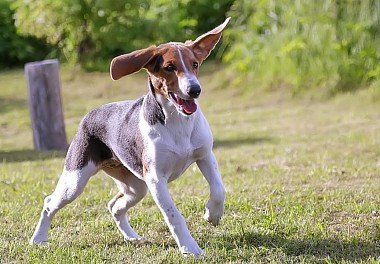

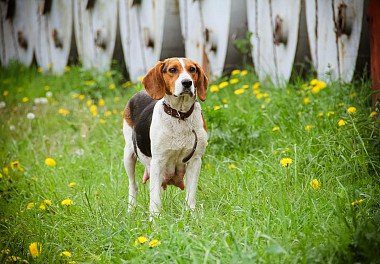

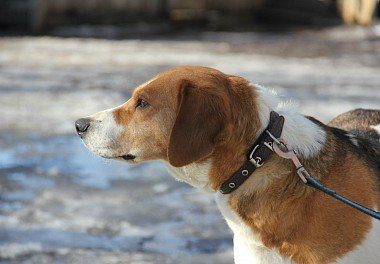

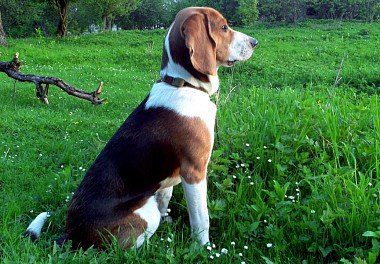

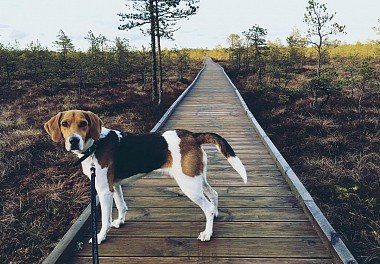

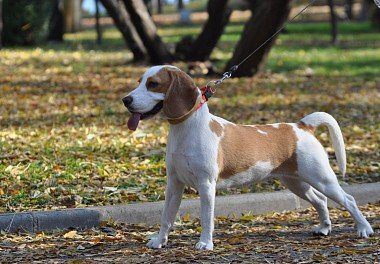

The nature of the Estonian hound
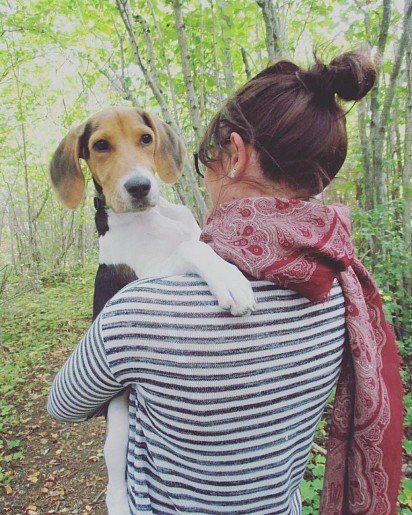

A professional hunter, uncompromising and merciless in the process of baiting the beast, the Estonian hound shows incredible friendliness to its owners. She leaves malice and assertiveness outside the threshold of the house, and within its walls she demonstrates an affectionate disposition, complaisance, devotion, patience, obedience. The good-natured nature of this dog allows it to be kept in a family where children grow up, as it shows amazing tolerance towards their pranks. Actually, the Estonian hound perceives the family as a pack, where the owner is the leader – she obeys him implicitly.
With other pets, the Estonian hound will live in friendship and harmony if it grew up with them. If you took an adult dog into the house, you will have to make a lot of efforts to nullify the conflicts that will inevitably arise between four-legged households, especially if the hound has to get acquainted with a representative of the cat tribe. It is desirable that the owner directly deal with the establishment of friendly relations between the four-legged.
A country house is the best place to keep an Estonian hound, but in a city apartment it can also feel quite comfortable if you give it the opportunity to expend its ebullient energy. Otherwise, this dog is unpretentious, besides it is surprisingly clean.
As for hunting, the Estonian hound is quite capable of starting to “work in his specialty” already at the age of six months, and some especially talented individuals already at 7-8 months become holders of diplomas obtained according to the results shown during field trials. When hunting, they very quickly take the trail and are able not to miss it for three whole days, or even more. The excitement and aggressiveness shown during work allow these dogs to get enviable trophies. Agility, sneakiness, as well as small stature – these are their advantages in the forest, they quickly and confidently climb through the bushes or into the deadwood, where the game is hiding, not giving it a chance to escape.
Despite the fact that the Estonian Hound was bred as a hunting dog, thanks to its courage, alertness and quick wit, it also performs excellent guard functions.
Образовање и обука
It is quite easy to train a contact and quick-witted Estonian hound – she grasps all commands on the fly. In addition to standard commands like “Sit!”, “Lie down”, “Give me your paw!”, She must certainly respond to the words “No!”, “Next!”. This dog should not be pampered – it will certainly strive to occupy an independent position, and it will be difficult to wean it from habits such as wallowing in the master’s bed and begging. The dog must know its place in the house, but brutal methods in its upbringing are unacceptable.
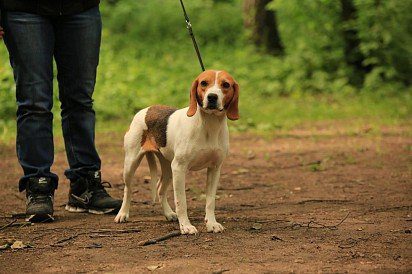

A future hunter needs to be trained in specific skills from puppyhood. Before you feed your pet, signal with a hunting horn. As soon as he appears, feed him – so he will develop a reaction to this invocative sound.
If you prepare an Estonian hound puppy for hunting from a tender age, then from the age of seven months he will be able to start working. But experienced owners of dogs of this breed take into account that their childhood is short, and they always approach the race with caution – preparing the pet to climb correctly, detect the beast, drive it without losing the trail. If a two-month-old puppy can simply be taken with you into the forest for an educational purpose, then a five-month-old dog can already be taught to navigate the terrain, to maintain contact with the owner, who may be far from her. The racing should be carried out systematically, commands should be worked out sequentially – from simple to complex, lessons should be repeated regularly, reinforcing the desired skills in the animal. During training, you need to monitor the dog: if he is tired, classes should be stopped. In no case do not use rude shouts if the dog is afraid to go into the forest. It is better to start the race with the black trope – this is the name of the autumn land, which has not yet had time to be covered with snow.
Attentive, responsible owners do not allow a dog whose age does not exceed a year to work at full strength, as this may adversely affect its health, especially the work of the heart. The Estonian hound can experience full loads when she is 1.5-2 years old.
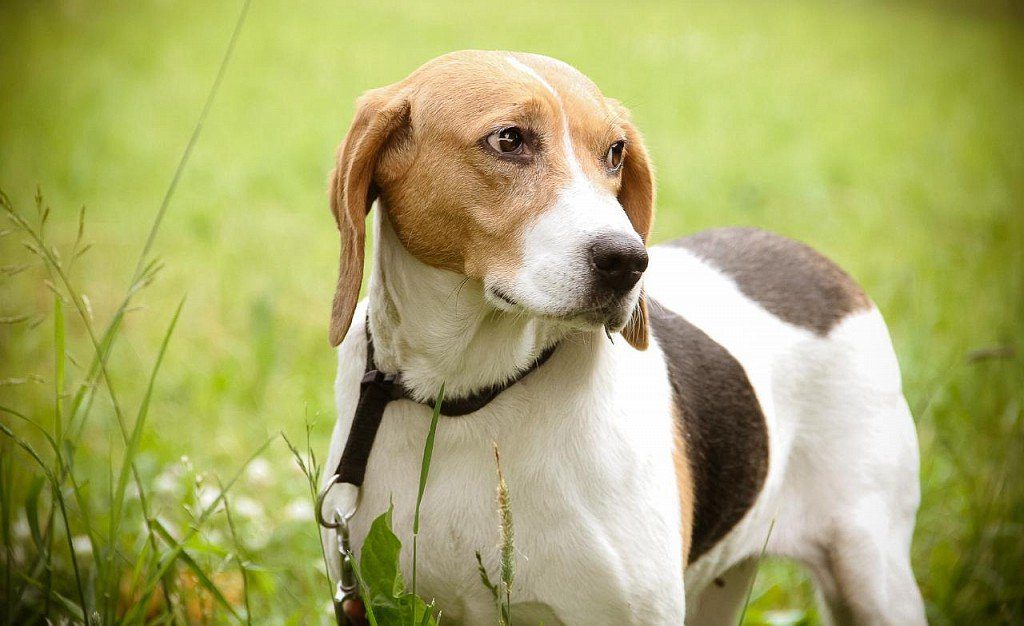

Care and maintenance Estonian hound
In the house, the Estonian hound does not take up much space, and, despite its mobility, is not prone to destructive actions. Since this breed is characterized by an almost complete absence of undercoat, and the coat itself is short, the owners are relieved of the need to scrupulously care for the coat of the animal. True, it is desirable to comb the dog more often, even daily. The procedure is carried out using a special comb for dogs with short, hard hair. Estonian hounds do not need frequent bathing, unless, of course, the hunting season is taken into account. They can be washed once a month, and in the summer, an alternative to bathing in a bathtub or a basin may well be swimming in the river, which these frisky dogs will be very happy about.
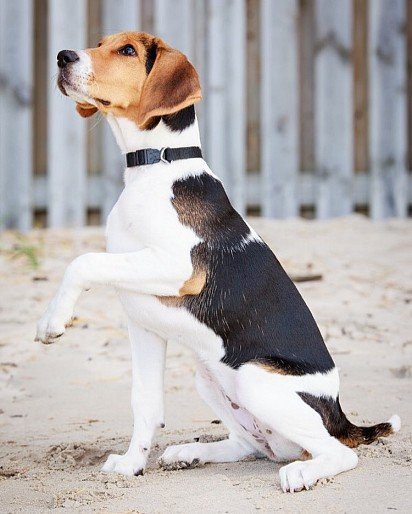

An Estonian hound living in a city apartment needs long walks. She will gladly go for a walk with her owner, become his companion on a cycle track or a morning jog. By the way, despite the fact that these dogs are very mobile, they are not inclined to tirelessly run, jump, haunting others.
You should walk your pet at least twice a day, and ideally this should be done four times: early in the morning, afternoon, evening and before bed. In total, it is desirable for the dog to overcome 4-5 km per day, while it is necessary to provide it with the opportunity to move at different speeds. A dog living in the city needs to run at least once a day without a leash so that he can throw out excess energy. However, it is dangerous to let Estonian hounds off the leash near roads and carriageways: if they are interested in the trace of any animal, they, guided by instinct, may stop paying attention to what is happening around, risking falling under the wheels of a car.
In food, the Estonian hound is not too picky, but its owners should not use this quality. It should be borne in mind that her diet should be more satisfying and high-calorie than the food familiar to non-hunting dogs. The pet is suitable for both natural food and dry food. An adult dog should be fed twice a day – in the morning and in the evening. It is desirable that the food was slightly warmed up. It is better not to offer chicken and large beef, pork bones to the dog at all, but he needs raw lean meat. Treat your pet with raw fish, a good option is flounder. Do not forget about vegetables, these vitamin products are simply necessary in the diet of the animal. Carrots are especially useful for a pet, which can be grated and combined with minced meat. Once a week, you can add some raw or boiled potatoes to the menu. Of the cereals, barley, barley, oatmeal are preferred. Millet can be given only occasionally.
Useful for animals and fermented milk products of low or medium fat content. Make sure that there is always water in the dog bowl, especially in hot weather.
Health and disease of Estonian hounds
The Estonian Hound belongs to the category of dogs that have a strong immune system and are rarely susceptible to diseases. They live up to 10-14 years. Among the most common diseases that are characteristic of this breed are arthritis, dislocations, torn ligaments resulting from physical exertion experienced during hunting, as well as otitis media – inflammatory processes in the ears that often develop in dogs with hanging ears.
A serious danger for the Estonian hound working in the forest is represented by ticks that carry piroplasmosis. After the hunt, the owner needs to examine and feel the animal, and at the first sign of the dog’s malaise (despondency, refusal to eat, thirst, blanching of the mucosa), immediately contact the veterinary clinic.
Како одабрати штене
The Estonian hound is not a very popular breed in the Russian Federation. These dogs are not very recognizable, so unscrupulous sellers often sell puppies of unknown breeds, under the name of the Estonian hound. Often, doggies bought “from hand” in the bird market do not even remotely resemble this breed with their exterior.
For a puppy, you should go to the nursery, where you need to carefully read his pedigree. If you are going to raise a real hunter out of a baby, make sure that his parents were not peaceful inhabitants of apartments, but seasoned hunters – holders of diplomas obtained after passing field tests. A puppy whose parents did not drive a single hare is unlikely to have well-developed hunting instincts.
When choosing a baby, examine him, paying attention to the fact that he should not have undershot bite or bulldogness, which is manifested in the fact that the lower jaw is longer than the upper one. The eyes of your chosen one should be as dark as possible. The dog should be active, look like a real strong man – powerful, bony, thick-legged.
Find out about the age of the intended pet’s mother. If she is less than one and a half years old or more than nine, there is a high probability that the puppy may grow up with developmental disabilities.
There is also the option of buying an Estonian hound puppy from a professional hunter, who skillfully knitted his own dog and is ready to share her offspring. Note, however, that he will probably keep the best heir to his bitch for himself.
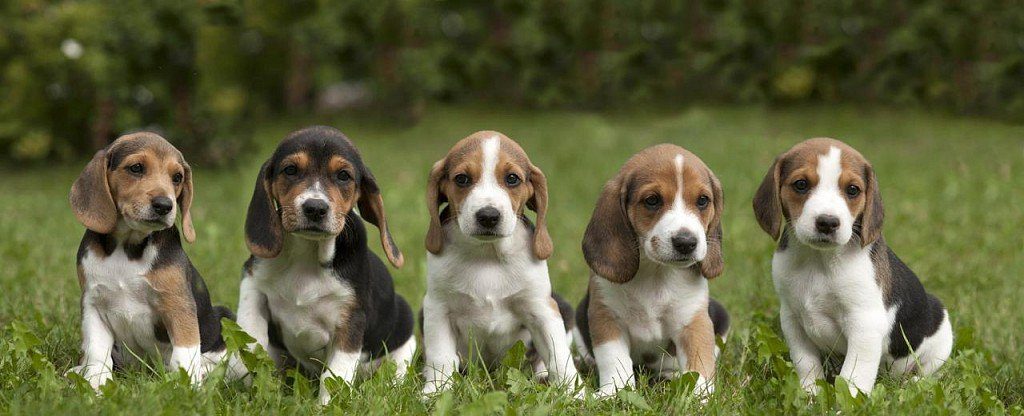

If you are buying an Estonian hound as a pet and are not going to fully use its hunting qualities, you can respond to ads on the Internet and buy a dog for 100$. However, ask the seller to let you know what the puppy’s mother looks like. Please also note that in this case, you will most likely have to deal with the vaccination of the animal yourself.
An Estonian hound puppy from a kennel whose parents were famous hunters will cost up to 500$.





